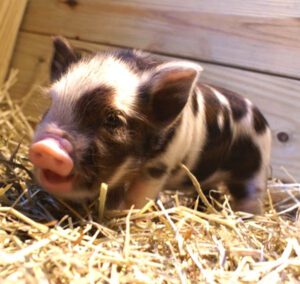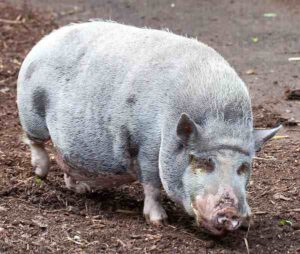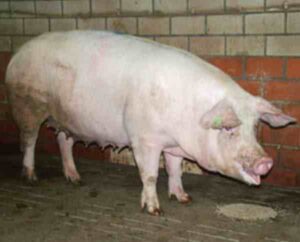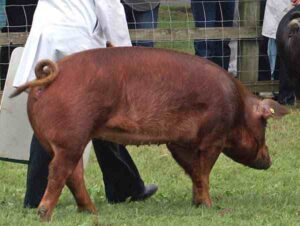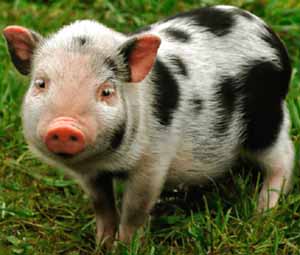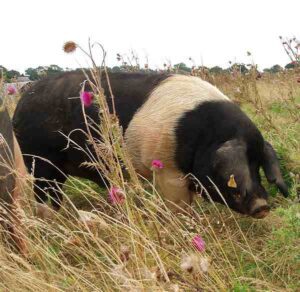The Kunekune pig is a breed of domestic pig which are hairy. Meaning of the word ‘kunekune‘ is ‘fat and round‘ in the Maori language.
Present form of the breed was developed from New Zealand. But it is actually of Asian origin according to the DNA analysis.
The breed is believed to have descended from an Asian domestic pig breed which were introduced to New Zealand in the early 19th century by whalers or traders. They differ markedly from the feral pig of European origin known in New Zealand as a “Captain Cooker“.
The Kunekune pig breed was adopted by the native Maori people of New Zealand. There were only an estimated 50 purebred animals remained in New Zealand by the 1980s.
But a breeding recovery program was started by Michael Willis and John Simister, wildlife-park owners. And that breeding recovery program in turn encouraged other recovery efforts.
As of 2010, with the help of breed societies in both New Zealand and United Kingdom, the breed no longer faces extinction. Two were imported into the United States from the United Kingdom in 1993.
Currently the Kunekune pig is widely spread throughout New Zealand. And as of 2004, there were about 5000 animals in the country.
The breed is also available in some European countries. Read more information about the breed below.
Kunekune Pig Characteristics
The Kunekune pig is relatively a smaller sized breed. It’s color ranges from black and white to ginger, cream, black, brown, gold-tip and tricolored.
Spotted animals are also available. Body of these animals is covered with hair which can be long or short, and straight or curly. They have a medium to short snout, that is black and either semilopped or pricked ears.

Body of the Kunekune pigs is short and round with short legs and two tassels under the chin.
Average height of the fully grown Kunekune pig is about 60 cm. And it is one the smallest breeds of domesticated pig.
Average live body weight of a fully grown animal can vary from 60 to 200 kg. Photo and info from Wikipedia.
Special Notes
The Kunekune pig is a very beautiful breed of pig. They are well known for their friendly nature, good behavior and docile temperament. And the breed is now often kept as pets like the Pot-Bellied pig.
Because of the calm and friendly nature, the breed is very suitable for a novice owner. The animals are placid and love human company. They are very intelligent and very easy to train.
Woodland ad pasture are the natural habitat for the Kunekune pig, as they love being outdoors. They are highly adaptable to a wide variety of environments and are suitable for a range of climates. They are very suitable for raising in a large garden.
Kunekune pigs grow well and they have the ability to fatten on little more than grass.
They are the only true grazing pig and can be maintained with grass alone without supplementary feeding. The boars become fertile within their 6 to 7 months of age, and the gilts can become pregnant at 5 months.
The Kunekune sows are excellent mothers, and their litters vary in size, averaging around 7 piglets. The piglets can be weaned usually at six weeks of age and the sows can be mated again after about a week of weaning her piglets.
The animals have an excellent ratio of meat to fat. Those animals produce nice pork which are killed before their one year of age. Pork of the breed is considered to be nicer by many than the faster grown commercial pig breeds. However, review full breed profile of the Kunekune pig in the following chart.
| Breed Name | Kunekune | |
| Other Name | None | |
| Special Notes | Beautiful, friendly, good behavior, docile temperament, good as pets, suitable for novice owner, love human company, very intelligent, easy to train, good for woodland and pasture, love being outdoors, high adaptable to a wide variety of environments, good for raising in a large garden, good grazers, fertile, sows are excellent mothers, excellent ratio of meat to fat, better taste than the commercially grown pigs | |
| Breed Size | Small | |
| Boars | Vary from 60-200 kg | |
| Sows | Vary from 60-200 kg | |
| Climate Tolerance | All climates | |
| Color | Many | |
| Rarity | Available | |
| Country/Place of Origin | New Zealand |

